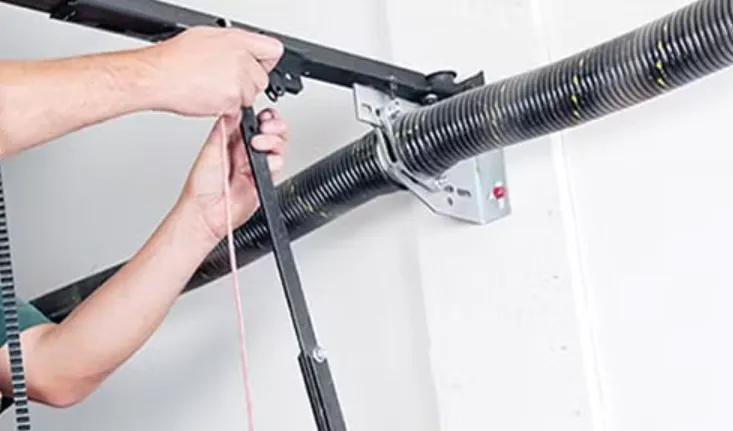There’s a universal feeling of frustration when you press the garage door remote and nothing happens. Your garage door refusing to open often occurs at the most inopportune times. Understanding the numerous scenarios under which a garage door might fail to open can be a stepping stone towards finding a solution. Whether it’s mechanical failure, power issues, or obstruction, each cause has its own set of solutions.
Uncovering the Common Causes
1. Power Failure
The simplicity of checking power sources is often overlooked. Ensure the garage door opener is plugged in. A blown fuse or a tripped circuit breaker could also be the culprit. Power issues are a common cause yet the easiest to fix. A quick glance at the circuit breakers and the plug can save you time and money.

2. No Power to Operator
It might sound obvious, but sometimes the issue could be as simple as the garage door operator being unplugged or a fuse being blown.
3. Remote Control and Transmitter Issues
A dead battery, syncing issues, or a blocked antenna on the remote control can keep your garage door firmly shut. Ensure the antenna on the motor unit is hanging down and is not damaged. Sometimes reprogramming the remote is all that is needed.

4. Obstruction
Your garage door has a reversing mechanism to prevent it from crushing objects in its path. Minor obstructions on the ground or within the tracks can cause the door to reverse or halt. A quick inspection and removal of any obstruction might solve the problem.
5. Mechanical Failure
Mechanical issues like misaligned tracks, broken tension springs, snapped cables, or a stripped gear in the opener can halt the operation of your garage door. Each of these issues carries its own set of dangers and it’s advisable to call a professional, especially with broken springs or snapped cables.
- Track Misalignment: A misaligned track can cause grinding noises and even prevent the door from moving. A severe misalignment warrants a call to a professional.
- Broken Tension Springs: These springs do the heavy lifting when the door opens. If broken, call a professional to replace them.
- Snapped Cables: If the cables snap, the door can fall causing potential harm. Seek professional repair.
- Stripped Gear in the Opener: A stripped gear could prevent the garage door from opening, necessitating a gear replacement or a new opener installed by a professional.
6. Sensor Malfunction
A misaligned or blocked sensor can halt your garage door. Clean the lens and ensure they are aligned. Sometimes, the wiring could be the issue, so a thorough check is advisable.
Photo-Eye Misalignment and Blockage: The photo-eye needs to be aligned and free from blockage for the door to operate.
7. Misadjusted Sensitivity and Limit Setting
Misadjusted settings can prevent the door from opening or closing completely. Adjusting the settings or calling a professional can resolve the issue.
8. Manual Lock Engagement
Sometimes the manual lock might be engaged unintentionally. Disengaging the lock could solve the problem.

9. Motor Deactivation
Motor deactivation is another simple but often overlooked issue. Reactivating the motor can get your garage door operational again.

10. Keypad Sync Issue
Sometimes the keypad could be out of sync, resetting the code or consulting the user’s manual can help resolve the issue.

Troubleshooting 101
-
Initial Assessment
Begin with an initial assessment to understand the extent of the issue. Basic checks include ensuring the power source is active, remote batteries are fresh, and there are no visible obstructions or damage. A systematic approach can help isolate the problem and determine whether it’s something you can fix or if it’s time to call a professional.
-
External Controls and Keypad
Verify the functionality of external controls and keypads. Sometimes, the keypad could be out of sync, and a simple code reset or a glance through the user’s manual could resolve the issue. Ensure the external controls are responsive and free from damage.
-
Manual Override
Familiarize yourself with the manual override feature, typically a cord or a switch, which allows you to operate the garage door manually when the automatic system fails. Know how to engage and disengage the manual override, as this can be a temporary solution while troubleshooting other issues.
-
Checking and Adjusting Limit Switches and Sensitivity
The limit switches and sensitivity settings tell the garage door opener how far to move the door and how much force to use. Incorrect settings can prevent the door from opening or closing completely. Adjusting these settings as per the manufacturer’s guidelines can restore the functionality.
-
Electrical Problems
Electrical issues such as a blown fuse or tripped circuit breaker can halt your garage door. Checking the fuse, circuit breaker, and the wiring of the garage door opener can unveil any electrical problems. If you’re uncomfortable dealing with electrical issues, it’s wise to call a professional.

-
Realigning or Replacing Sensors
Sensors out of alignment or faulty can prevent the garage door from operating. Realignment or replacement can resolve the issue. Ensure the sensors are clean, properly aligned, and free from physical damage.
-
Replacing Broken Springs or Cables
Broken springs or cables are a more serious issue and replacing them can be dangerous. It’s advisable to seek professional help for such repairs. However, understanding the issue can help you communicate better with the repair technician.
Prevention is Better than Cure
1. Regular Maintenance:
Regular maintenance can prevent many common garage door issues. Schedule routine checks, keep the tracks clean, and lubricate moving parts to ensure smooth operation.
Following a regular maintenance schedule can help prevent common garage door issues. Below is a Maintenance Schedule Table to guide you. For more insights, check out our garage door maintenance tips:
| Maintenance Task | Frequency | DIY or Professional |
|---|---|---|
| Lubricate Moving Parts | Every 6 months | DIY |
| Sensor Cleaning | Every 3 months | DIY |
| Track Alignment Check | Annually | Professional Recommended |
| Spring Tension Check | Annually | Professional Recommended |
2. Sensor Shielding:
Protect your sensors from dirt, dust, and physical damage by using protective covers or simply by keeping the area around them clean. Regular cleaning and checking alignment can prevent many sensor-related issues.
3. Understanding Your Garage Door:
Familiarize yourself with the various features of your garage door system, including the manual override. Knowing how to engage the manual override in case of an emergency or a malfunction can be a lifesaver.

Understanding the average lifespan of various garage door parts can help you anticipate potential issues and schedule maintenance or replacements accordingly. The following table outlines the expected lifespan of key garage door components, along with notes on how to potentially extend their functionality:
| Garage Door Part | Average Lifespan (Years) | Notes |
|---|---|---|
| Springs | 7 - 9 | Lifespan can extend with regular maintenance and less frequent usage. |
| Garage Door Opener | 10 - 15 | Quality of installation and brand may affect lifespan. |
| Rollers | 2 - 3 (plastic), 10 - 20 (steel) | Steel rollers tend to last longer than plastic ones. |
| Tracks | 10 - 20 | Keeping tracks clean and aligned ensures longer lifespan. |
| Cables | 10 - 20 | Regular inspection for frays or damages can prevent sudden failure. |
| Sensors | 10 - 20 | Keep clean and properly aligned to ensure functionality. |
When to Call a Professional?
-
Evaluating the Issue
There comes a point when DIY troubleshooting reaches its limit. When faced with complex issues, especially those related to electrical systems or mechanical components that carry high tension, it’s prudent to seek professional help. Recognizing when to call a professional is crucial to prevent further damage or personal injury.
-
Choosing a Reputable Service
Finding a reputable garage door repair service is essential for quality work. Look for services with good reviews, appropriate licenses, and insurance. It’s also garage door repair to get multiple quotes to ensure you’re receiving a fair price. Your peace of mind and the safety of your home are paramount, so take the time to choose wisely. Explore more on how to select a garage door.
-
Understanding Warranties
Warranties can save you a lot of money and hassle. Familiarize yourself with the warranties on your garage door and opener, and understand what is covered under these warranties. Some repairs or replacements may be covered, which can significantly reduce the cost.
Legal and Safety Considerations
-
Adhering to Safety Guidelines
Safety is paramount when troubleshooting garage door issues. Always ensure the power is disconnected before working on electrical components, and be cautious when working with high-tension parts like springs and cables. Your safety should never be compromised in the DIY process. You can read more on essential garage security tips.
-
Understanding Liability
When you decide to DIY or hire a professional, understanding the liability involved is crucial. DIY repairs may void warranties or leave you liable for any accidents that occur. On the other hand, ensuring the professional service you hire is insured can protect you from liability in case of accidents. For more insights, visit common types of garage door locks.
Frequently Asked Questions (FAQs) on Garage Door Troubleshooting
What do you do if your garage door won’t open?
Start with basic troubleshooting: check the power source, remote batteries, and ensure there are no obstructions. If these don’t resolve the issue, refer to the troubleshooting section of this guide or consider calling a professional.
Why is my garage door not opening but the motor is running?
This could be due to a disengaged trolley, broken gears, or other mechanical issues. It’s advisable to check the mechanical components or consult a professional to diagnose the issue. More on common garage door problems.
Why does my garage door opener blink but not open?
Blinking lights on a garage door opener often indicate a sensor issue. Ensure that there are no obstructions and that the sensors are aligned. If the issue persists, refer to the troubleshooting guide on sensor realignment.
How do you reset garage door sensors?
Resetting garage door sensors typically involves unplugging the opener, waiting for a few minutes, and plugging it back in. If necessary, refer to your owner’s manual for specific instructions.
What do you do when your garage door won’t open?
Similar to the first question, start with basic troubleshooting steps. If the problem persists, consult a professional garage door repair service.
What causes garage door opener to stop working?
Various factors could cause a garage door opener to stop working, including power issues, mechanical failures, or sensor malfunctions. Regular maintenance can help prevent some common issues.
How do I reset my garage door motor?
Resetting the motor usually involves unplugging the unit, waiting, and then reconnecting it. Always refer to the owner’s manual for the specific procedure for your model.
Final Thoughts
This comprehensive guide provides insights into common garage door issues and their solutions. Whether it’s a minor obstruction or a significant mechanical failure, understanding the basics can save both time and money.
Regular maintenance is essential to ensure the longevity and reliable performance of your garage door system. However, certain situations warrant professional assessment and repair.
Engage with the community by sharing your experiences and tips in the comments below. If you’re facing an issue that requires professional help, don’t hesitate to contact a reputable garage door repair service. Your safety and the functionality of your garage door should always be the priority.
For more insights and related topics, explore the garage doors guide and keep your garage door operating smoothly.
Further Resources to Explore





